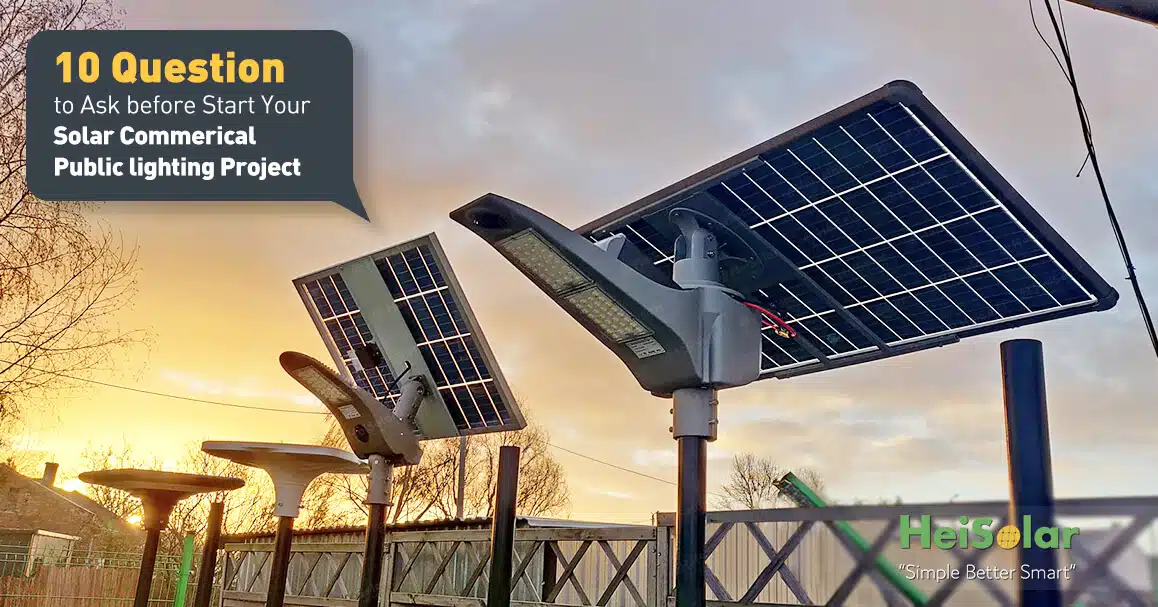Leave a Comment / By Rachel / November 3, 2022
When you install a traditional commercial light, you don’t often need to be worried about whether it will be “bright” enough or will work continuously because there is an expectation that it will operate as specified. You dig the trench, lay the cable, connect to the public utility, and bam-you has the lighting.
However, a properly sized modern commercial outdoor solar lighting system is a fantastic option if you want to avoid expensive and time-consuming trenching options, and you’d rather not pay any ongoing electricity costs. While solar commercial lights can achieve the same lighting results as traditional lights, there are some specific things you need to evaluate to make sure you get the right results.
Why are these questions being asked?
Avoid overspending by making sure the lighting system uses the right-sized components for your project’s requirements rather than using an unnecessary pricey system to make up for bad design.
Avoid battery changes or automatic shut-offs by installing a system that will be able to meet your long-term lighting needs rather than one that causes the lights to dim, causes the battery to fail too soon, or turns the lights off entirely.
Q1. Ask About The Project Location
Where exactly is the project located?
Try to get precise street addresses and site descriptions whenever feasible. Why? This enables the manufacturer’s designers to take solar insolation information into their system design. Different areas receive different amounts of sunlight each day. For example, a solar light specified for sunny, southern California would be smaller and therefore wouldn’t be able to generate enough power to provide continuous light for New York City. And a solar light specified for New York City would be unnecessarily large for California.
Knowing the project location allows the manufacturers to build and specify their systems for your exact location and to avoid proposing a system that’s too small or too large for your area.
Additionally, a street address enables the evaluation of potential shading risks, such as trees, structures, or other impediments that could shade the solar panel and reduce the efficiency of your system.
Q2. Ask About The Project Application
What kind of area are you trying to illuminate? Is it street lighting or area lighting? Knowing the basic type of street vs. pathway will change the lighting output requirement.
Why? The application may have an impact on the necessary light levels, pole height, and pole spacing. For instance, a street probably needs more light than a park or trail. Here are some possible applications:
Urban Roads
Residential street
Pathway & park
Recreational Reserve
Parking lots
Perimeter & Security entryway
General Public Area
Q3. Ask About The Project Dimensions
What is the length of the street/pathway or the size of the general area (for a parking lot, etc.)?
How much area are you trying to illuminate?
Why? The size or length of the area will affect the number of lighting systems required, and the uniformity of the light hitting the ground, which all factor into the overall project cost.
A PDF or CAD of the installation site will help the designer to realize your project in a more professional way.
Q4. Ask the Project Type
New Installation Projects
Retro-fit
Replacement of Failing infrastructure
Temporary installation
Q5. Ask About The Pole Details
Will your project require pre-existing poles or new poles?
Is there a specified pole height request? What’s kinds of poles are required? like a single-arm or double-arm pole or without an arm pole.
Why?
The height of the pole may affect the number of lighting systems required for the project.
The type of light pole may affect the cost of installation.
Height of typical streetlights: 25 to 30 feet
Height of typical walkway lights: 12 to 20 feet
Typical light pole types:
adjustable cone-shaped poles, Conical poles, octagonal poles, straight pole
If there are frequent typhoons or hurricanes in the area, your customers will also have a certain demand for the wind resistance rating of the light pole.
Q6. Ask About The Installation type
After we know the Road Width, Road lanes, and Road length, we are going to consider which installation type is suitable for our project. There is some common installation type to u check:
Installation pole height and Installation distance ( If it is a new installation project, this condition can be adjusted in the design process)
We will choose whether to lay the lights on one side, on both sides, or to cross the lights, depending on the road conditions.
1. single side installation
2. double side installation
3. double arm middle installation
Q7. Ask About The Required Light Levels And Uniformity
Is there a state/municipal standard for light levels for the project, what are they? What light levels need to be met on the ground (measured by foot candles or lux)? What uniformity requirements are there if known?
Why? Different applications will require different light levels, which plays a large role in determining the overall project cost.
Manufacturers can make a lighting design by Dailux Simulation for your project to make sure the lux and uniformity match your lighting requirement.


Hi, this is a comment.
To get started with moderating, editing, and deleting comments, please visit the Comments screen in the dashboard.
Commenter avatars come from Gravatar.